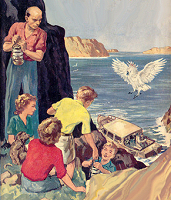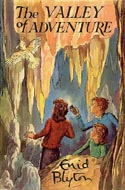
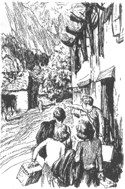
After landing in the deserted valley, the children find a dry barn to set up camp.
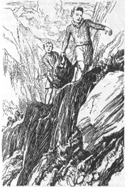
The children find a better hiding place...
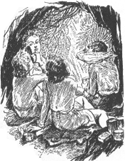
... a nice cave tucked away near a waterfall!
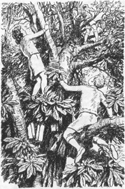
A great tree to spy on the bad men down below in the valley!
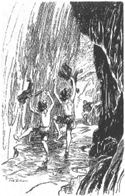
To prevent the bad men following Jack and Philip to the cave, the girls distract them from the safety of the waterfall.

Otto, having escaped from the bad men, draws Jack a treasure map!

Philip finally seeks help from a startled policeman.
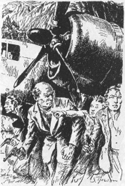
Bill in action! The bad guys are rounded up!
The Valley of Adventure
Review by Keith Robinson (April 5, 2005)
There's no pussy-footing around with the opening scenes of the third book in the Adventure series. The children arrive back home after a trip in Bill's new plane (which he's been assigned to help him with his job, the lucky blighter!) and are terribly excited about the whole thing. Bill announces he'd like to take the children on a night flight to his home, and stay for a few days. Naturally the gang are over the moon! But, in Chapter 3, something goes horribly awry and the children end up in the wrong plane – with two obviously bad men at the controls. So, by Chapter 4, the children are marooned in some valley in the middle of nowhere in a foreign country!
With this rapid plunge into adventure (just after Philip had promised his mother not to get into any more!) it's hard to imagine how Enid Blyton can prolong the interest throughout the rest of the book. But she does. The children find themselves in a beautiful but deserted valley, with nothing but a number of burnt-out houses and buildings to indicate that people once lived there. With mountains all around, it seems the children are stuck there – with no one but a couple of bad guys for company, who have a little hut where they keep a stock of tinned food and supplies. The children manage to steal some of the food and go off to hide somewhere, at first in a cowshed. But when the men find signs that someone has been there, the children venture further up into the mountain... and find a perfect little cave near a waterfall that has a soft, dry, moss-covered floor and ferns to conceal the entrance. It's perfect! – and every kid's dream!
But this is just the beginning of their stay in the valley. The men are searching for something... but what? When the men fly off in their plane and return with a third bad guy and another man, evidently a prisoner, things get even more puzzling. Jack and Philip decide to follow the men as they set off on a trek across the valley. The prisoner, who apparently is supposed to be leading the men to a specific place, eventually stops before a rockfall and points. This, he seems to be saying, is where the entrance is – or was. Frustrated, the men try to shift the rocks but can't. Later, when the children rescue the prisoner, a man called Otto, he lets on in a heavily-accented voice that there is "treesure" in the valley. The entrance is not under the rockfall after all – that had just been a clever trick! – but somewhere up in the mountains. He draws a map... and the treasure hunt is on.
Many more exciting things are to follow. The mountain is riddled with tunnels and caves, just as you might expect from an Enid Blyton novel, and of course Jack, Philip, Dinah, and Lucy-Ann manage to find their way about, bit by bit. The whole book is steeped in vivid description and atmosphere, and the exploration of the caves is really top-notch stuff. After discovering their friendly little moss-covered cave, which they set up as a temporary home, Lucy-Ann comes across a tunnel at the back leading into a vast cavern which echoes madly. They call this the Cave of Echoes. It leads through to an opening behind the waterfall, a ledge that is unapproachable from any other route. This proves useful later! But it's during the hunt for the treasure that Blyton excels herself, with The Cave of Stalactites first, followed by the Cave of Stars (with little twinkling points of light that "might be glowworm"). After a long tunnel and finally some steps cut into the rock, they come to a door, and beyond the door... well, you just have to read the book!
Even the walks up and down the mountain, through the forests, clambering over rocks and up to Windy Pass (which is blocked and sadly impassable) are described in loving detail. Has Enid Blyton been to this valley? Does it exist? It's too exciting and adventurous to be really true, but golly, she does a good job of making the readers believe in the place.
So is this book perfect in every way? Hmm. It's pretty close. The baddies are somehow more believable than usual, but that's probably because the children make sure to steer clear of them at all costs – so there is hardly any physical contact between them. Even when there is, when one of the bad guys captures Jack, Blyton cleverly uses the wind to dislodge a suitcase from a tree, which clocks the bad guy on the head. (I should point out that the suitcases were stuffed up the tree earlier in the book; it's not like they were just thought up on the spur of the moment!) One thought that kept occuring to me throughout this book, moreso than others in this series so far, is the matter of going to the toilet. All right, so Enid Blyton characters don't go to the toilet. We know that. They're above such nasty, disgusting, unmentionable things. But still... there are times when you really have to wonder about it. Also, towards the end – when we're reminded that their suitcases are still up a tree where they'd left them early on – I had a horrible image of these kids wearing the same underwear throughout their entire stay! And they are there at least five or six nights, probably more. If anyone cares to confirm this, I'd be glad to add this here, as I think it's important to know just how filthy and disgusting those Mannering and Trent children really are! ;-)
Philip's escape from the valley is fantastic. I had no idea/recollection what was coming until I read it, but when Philip emerged from a crate covered in straw at a small railway station in Scotland, I had a flashback and knew I'd enjoyed that moment long ago when I first read these books. This is also when we find out that Bill Smugs/Cunningham is a Detective Inspector. Somehow this lessens his mistique a little; I think I saw him more as MI5 or something. I can't help thinking that other Detective Inspectors on the police force might be a little jealous of Bill's "company vehicle" – a plane, for heaven's sake! As I said above: lucky blighter.
Finally, a few words about the children themselves. Dinah's temper tantrums are all but gone now, although there was one particular moment that stood out as a little odd. When they were trapped inside the mountain, Dinah got very frustrated and snapped at Lucy-Ann for no reason, and I couldn't help thinking this was some kind of foreshadowing for something to come. But no, I think it was just an odd moment inserted to throw in some realistic emotion considering their predicament, almost as an afterthought. Meanwhile, Lucy-Ann is very Lucy-Ann-ish, and her character alone is probably the most consistent throughout the series so far. Jack and Philip are a little interchangeable in this book, despite Philip's perfunctory "pet" lizard – although there was a moment where Philip had the idea to escape, and Jack said, "Sounds easy, but it won't be. Better let me do it, Tufty." I thought this was a bit condescending all of a sudden. I always considered Jack and Philip equals in their adventurous nature, despite Jack being a little older. Oh, and one thing that made me roll my eyes was Bill's statement at the end that the very men the children had got caught up with were the very men he'd been after for some time. Now, there's a surprise!
An incidental quibble: There are lots of typos in this book, and as I've said before, they start to irritate after a while. It makes me realize just how perfectly copy-edited most books are these days. So why do these Blyton books contain so many punctuation errors? – missing quote marks at the beginning or end of speech, or simple spelling mistakes like "went" instead of "want"? Are these the author's uncorrected errors? Or perhaps they're caused by later editions during typesetting? The most blatant mistake was right at the beginning of Chapter 30. The first paragraph reads...
Bill swung out of the car, took hold of Philip by the arm and had at good look at him. "You're all right?" demanded. "All of you? Your mother's been nearly off her head with worry."
I wonder if earlier editions have the same error, the missing word "he" before "demanded"? Confirmation, anyone? Anyhow, overall I agree with other fans that this book is probably the best in the series. For me, reading these in order as I go, this is certainly the best so far – the best of three excellent books. Hopefully the rest of the series is as entertaining.
Heather from Australia adds: "Re. your query on the Valley review about the missing word – my (1955) copy has the word there. I have also noticed very few punctuation/grammar problems in my copies – I think it must be the publisher of the new versions?"
Thanks, Heather – I had a feeling it was more likely to do with sloppy handling by later publishers. Tsk! If I were the author and my books were being slowly butchered by political-correctness and stupid punctuation errors and typos, I'd be mightily miffed.


